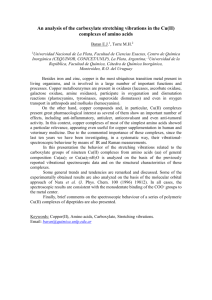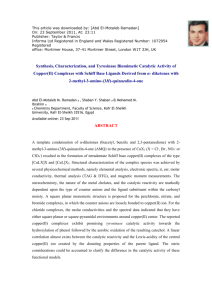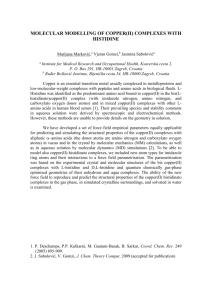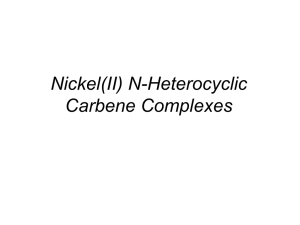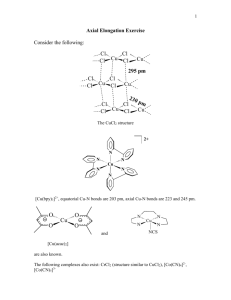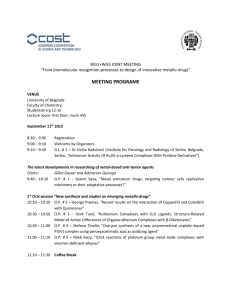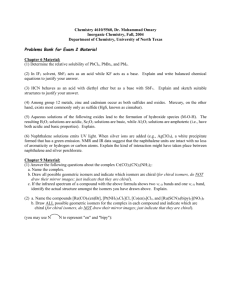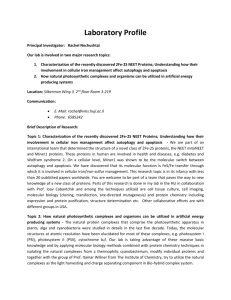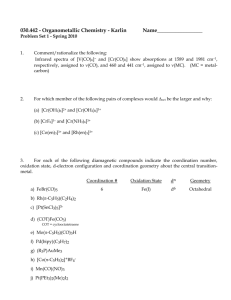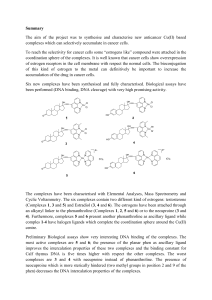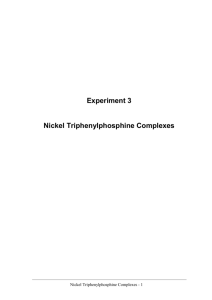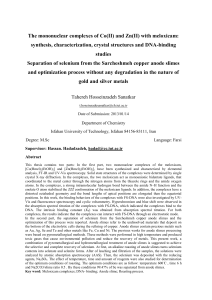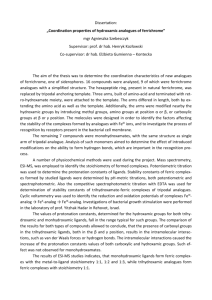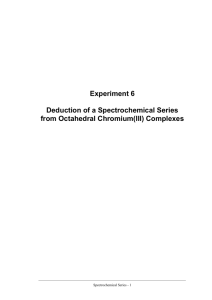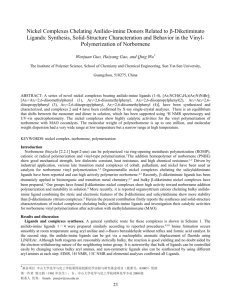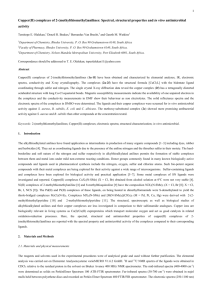Nickel and copper groups
advertisement
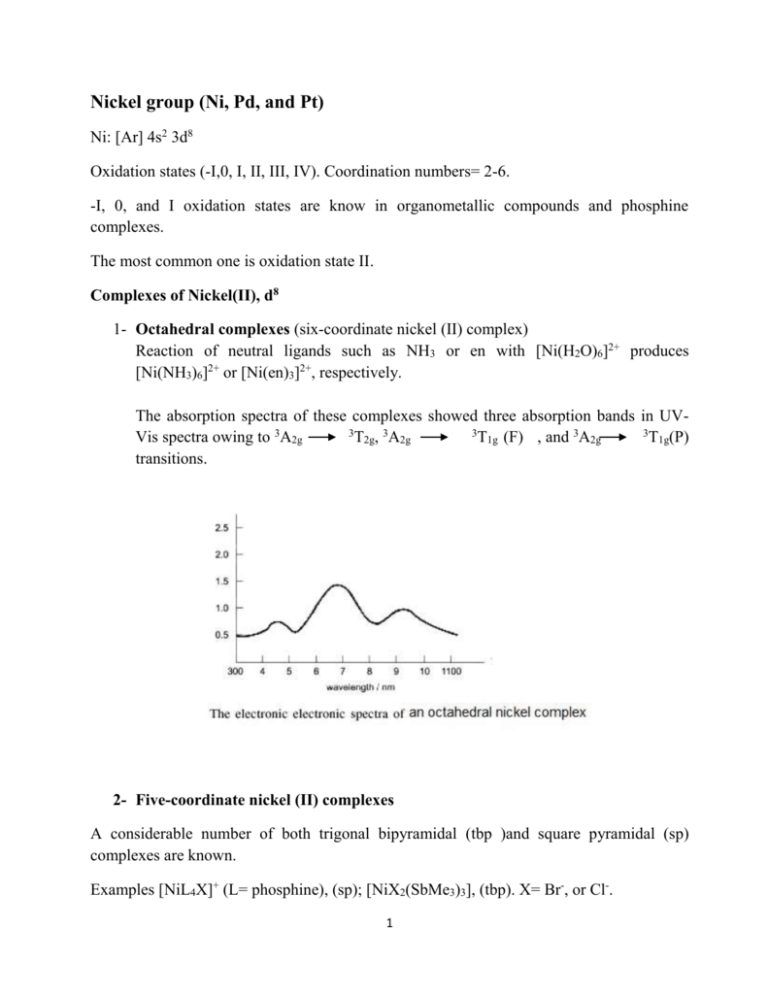
Nickel group (Ni, Pd, and Pt) Ni: [Ar] 4s2 3d8 Oxidation states (-I,0, I, II, III, IV). Coordination numbers= 2-6. -I, 0, and I oxidation states are know in organometallic compounds and phosphine complexes. The most common one is oxidation state II. Complexes of Nickel(II), d8 1- Octahedral complexes (six-coordinate nickel (II) complex) Reaction of neutral ligands such as NH3 or en with [Ni(H2O)6]2+ produces [Ni(NH3)6]2+ or [Ni(en)3]2+, respectively. The absorption spectra of these complexes showed three absorption bands in UV3 3 3 Vis spectra owing to 3A2g T2g, 3A2g T1g (F) , and 3A2g T1g(P) transitions. 2- Five-coordinate nickel (II) complexes A considerable number of both trigonal bipyramidal (tbp )and square pyramidal (sp) complexes are known. Examples [NiL4X]+ (L= phosphine), (sp); [NiX2(SbMe3)3], (tbp). X= Br-, or Cl-. 1 3- Four-coordinate complex A-Tetrahedral complexes: Ni(L-L)2 They have bulky ligands. This is a paramagnetic complex with S=1 t2 e B- Square planar complexes For the vast majority of four-coordinate nickel(II) complexes, planar geometry is preferred. Almost all planar complexes of Ni(II) are diamagnetic. Example: bis(dimethylglyoximato)nickel(II) complex. Its color is red. 2 Organometallic Nickel Complexes -Ni(CO)4 and its derivatives are known. -Nickelocene NiCp2 is readily obtained from the reaction of Cp- with NiII salts. -The reduction of NiII salt in the presence of 1,5-cyclooctadiene (COD) affords the yellow crystalline Ni(COD)2. 3 Ni(COD)2 Copper group Cu, Ag, and Hg. Cu:[Ar]4s13d10 For copper metal, first ionization energy is higher than those of the alkali metals owing to the incomplete shielding of the nuclear charge by the filled d shell. For copper metal, sublimation and melting points are higher than those of the alkalis because the electrons of the d shell are also involved in the metallic bond in the copper metal. Oxidation states (I, II, and III) Estimation of Cu2+: Addition of KI to a solution containing Cu2+ results in the I- ions reducing Cu2+ to copper(I) iodide CuI and at the same time I- is oxidized to I2. This reaction is used to estimate Cu2+ in solution by volumetric analysis. Excess KI is added to an acidic solution and the I2 produced is estimated by titrating with sodium thiosulfate, as follows: 2Cu2+ + 2NaS2O3 + 4II2 2CuI + I2 Na2S4O6 + 2NaI Reaction of CN- ions: Cyanide ions may react with Cu(II) ions in two ways: 1- As a reducing agent 2- As a complexing agent Thus adding KCN to a CuSO4 solution first causes reduction and precipitates copper(I) cyanide. This reacts with excess CN-, forming a soluble four-coordinate complex [Cu(CN)4]3- which is tetrahedral in shape. 4 2Cu2+ + 4CN- 2CuCN + (CN)2 cyanogene CuCN + 3CN- [Cu(CN)4]3- Complexes: Tetrahedral, square planar and octahedral complexes for Cu2+ ion are known. However, most of the Cu(II) complexes and compounds have a distorted octahedral structure and are blue or green. The metal ion has the d9 electronic configuration. This leaves only one hole into which an electron may be promoted, so the spectra should be similar to the d1 case (e.g. Ti3+) and have a single broad absorption band. This is observed, and complexes absorb in the region 11000-16000 cm-1. However, octahedral complexes of CuII are appreciably distorted (Jahn-Teller effect) so there is more than one peak. These overlap so the band is not symmetrical. Copper(II) carboxylates These are readily made by interaction of the acid with CuCO3. They are binuclear with four carboxylate bridges. In these compounds the Cu-Cu distance varies from 2.44 to 2.88 ̊A. There is a weak coupling of the unpaired electrons, one on each CuII ion, giving rise to a singlet ground state with a triplet state lying only a few kilojoales per mole above it; the latter state is thus appreciably populated at normal temperatures and the compounds are paramagnetic. At 25 ̊C, is typically 1.4 MB/Cu atom and the temperature dependence is very pronounced. 5
